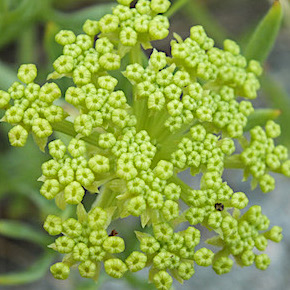
The yellow-green flowers of Rock Samphire brighten the coastline through the summer months.
Photo: Amanda Scott
Scientific name: Crithmum maritimum
Other common names: Sea Asparagus, Sea Fennel
What to look for:
· Family: Apiaceae (Carrot (umbellifer) family).
· Flowers: Umbels, 3 to 6 cm in width, of yellow-green flowers
· Leaves and stem: Fleshy, divided leaves and ridged stem
· Height: Up to 30 cm.
· Where: Grows on maritime cliffs, rocks and stable shingle, on the south and west coasts of Great Britain and Europe.
· When: Usually flowers from June to August.
· Habit: Upright.
With its yellow-green flowers in summer, held in umbels above the fleshy leaves, Rock Samphire is one of our more distinctive coastal plants. Even out of the summer flowering season, the yellowing stems and leaves are easy to identify.
Rock Samphire is edible. Best picked when young in the earlier part of the season, it tastes particularly good lightly steamed with fish. When foraging, just a few stems should be taken from each plant, to ensure sustainability.

Did you know…?
…Shakespeare mentions Rock Samphire (as ‘samphire’) in King Lear.
…The seventeenth century herbalist Culpeper described the leaves as having a ‘pleasant, hot and spicy taste’.
More information and references:
Mabey, R., 1997. Flora Britannica. Chatto & Windus, London.
Rose, F. and O’Reilly, C., 2006. The Wild Flower Key, 2nd edition. Frederick Warne, London.
Stace, C., 2010. New Flora of the British Isles, 3rd edition. Cambridge University Press, Cambridge.
Published: April 2016
Author: Amanda Scott
Photos: Amanda Scott
